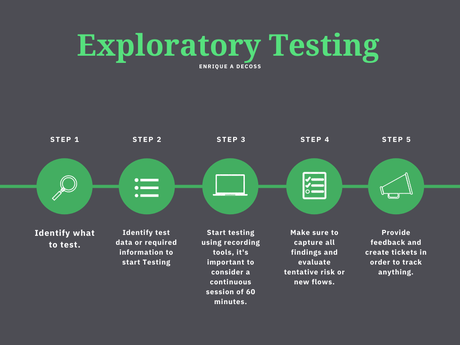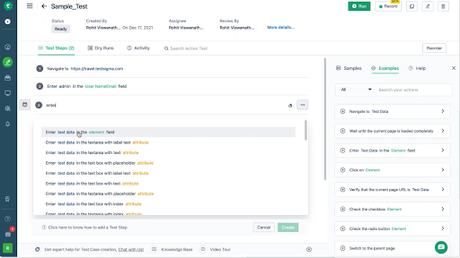The world is entering a new age of technology. Low-code/no-code tools are already becoming a mainstay for many global teams. By going no-code/low-code, teams can now fill in the gap between the accelerating demands of application delivery and team skill sets. While these tools are nicely on their way to becoming mainstream for development, similar ones for test automation are pushing their way into the market.
 credits: me
credits: me 
No-code/low-code automation tools are believed to solve the challenge of simplifying Testing for Agile QA teams at different levels, plus handling the growing complexity of the software itself. In addition, the adoption of CI/CD and continuous testing practices in the Agile world has changed how product development teams deal with their updates in many ways: release more and release faster than before.
Therefore, test automation solutions today need to make testing accessible to those with a certain level of coding skills and those without coding skills.
Agile Testing and the challenge of going faster
Agile teams are constantly asked to do more with less and release faster without sacrificing the quality or increased spending. As a result, many Agile teams look to test automation to meet these demands from internal clients and end-users.
But, as we already know, traditional test automation comes with its fair share of challenges.
Many companies have invested a lot of time and resources into automation and those further behind in their automation maturity and strategy. As part of the current state of test automation, many companies have minimal levels of test automation today, mentioning that the reason for that is they don’t have the necessary resources to support it. One reason is a lack of skilled and/or experienced test automation resources.
Agile Teams that have achieved higher levels of test automation encounter a much more diverse group of challenges. For example, companies that have invested heavily in Test Automation believe they progress too slowly, and do not notice the expected level of coverage from it.
The challenges appear to be inhibiting the effectiveness and adoption of Test Automation. According to Forrester’s State of Agile reports, the percentage of automated test cases is barely growing. In 2015, 49% of respondents communicated they always tested manually. That number dropped to 46% in the 2017 version of the report but hit a plateau in 2019, where it remained at 46%.
No-code/Low-code testing tools helping Agile Teams
As we are aware, traditional automation requires experts in coding to script tests at the outset and maintain them over time. In addition, the complexity and need for different tools for automation like Appium, Selenium, element locator, locator strategies, and so on add to the complexity of traditional Test Automation and the need for specific expertise.
Some companies are misleading the QA teams and moving into development roles, which usually indicates that test automation projects get stuck midway through and are not fully completed, resulting in a massive waste of time, money, and people.
The value of no-code/low-code test automation tools, on the other hand, is that anyone can do it. With a no-code/low-code solution, a user moves through a test case, and the testing tools can transcribe that experience into an automation script. In addition, no-code/low-code testing tools were initially addressed only for web applications.
Today, many more tools offer the ability to run sessions and create test automation scripts on mobile (Android and iOS), API Testing, and some functional testing areas.
Although developing with low-code and no-code often accelerates the development process and enables more straightforward enhancements, DevOps teams should still perform testing and configuration reviews.
Using a no-code/low-code testing platform, we can significantly reduce the time and cost involved while also decreasing our dependence on test automation engineers. In addition, regular coders and even non-coders can now generate test scripts.
Finally, Testers can now focus on the business needs of the software, ensure customer-centric scenarios, and perhaps more test coverage.
Ideally, traditional automation and no-code/low-code testing tools should maximize the speed and quality of software delivered to end-users.
Still, I genuinely believe modern automation should use no-code/low-code testing and deliver high-quality applications faster.
The Future of Agile Teams and no-code/low-code automation testing tools
Technology is constantly changing, but at this moment, there are no tools to build software tests that perfectly run and identify bugs automatically with a single click. However, we can’t deny that it’s easier than ever to run automated software tests faster with no-code automation tools using advanced AI and ML techniques.
Agile Testing approaches that we need to include in our Scrum Teams:
User Acceptance Testing
Agile brought user acceptance testing into all stages of the software development process. Proper user acceptance testing goes beyond asking business stakeholders to explore the application, try out new features, and find issues. Instead, a successful UAT requires thorough planning and execution, just like any other test.
Keeping UAT in sync with specifications is challenging in Agile projects where changes happen frequently. In addition, due to its heavy focus on end-user Testing, UAT also overlaps with UI testing, which tends to be less change-proof.
One of the critical advantages of no-code/low-code testing tools is the speed you can create and edit tests. In addition, the speed boost you get from not having to code your tests makes it possible to cover new features with tests quickly.
Exploratory Testing in Agile
Exploratory Testing is a cyclical method, progressing from design > execution > analysis > learning before beginning the loop again. As we already know, Exploratory Testing can’t be automated; instead, Agile testers must create the exploratory testing session on the go, requiring the tester to use their unique skill set fully.


Exploratory Testing is the closest testers get to interact with an application. It’s a great way to find out if you have some working application quickly, and allow testers to identify bugs that would not be found through other testing methodologies. No-code/low-code testing tools can free up Agile tester’s time to perform Exploratory Testing sessions every sprint.
Behavior-Driven Development
BDD is a collaborative approach that creates a shared understanding of requirements between the business and the Agile teams. Its purpose is to help guide development, reduce rework, and increase flow. BDD tests are customer-facing scenarios that try to describe the behavior of a Story, Feature, or Capability from a user’s perspective.
BDD facilitates the shift from functional Testing to automated Testing thanks to an understandable language that eliminates complex test script syntax (TDD).

Many no-code/low-code testing tools facilitate the BDD approach providing a Natural Language processor; if the test cases are created using Natural Language, they are understandable for users at all levels. Including Product Owners, TPMs, QA Managers, stakeholders, etc. It means any team member can look at the test cases and review them if needed.
In today’s Agile world, we can recognize teams who don’t want to use no-code/low-code automation tools and other groups willing to learn about those tools and apply them in their scrum teams.
A few years ago, I witnessed the same pattern between people who knew how to use Agile methodologies and those reluctant to switch from waterfall methodology (AgileFall).
Final Thoughts
The greatest thing that can be done to ensure the success of Agile Testing for an application is to hire people who have the essential characteristics of an Agile tester and build a culture of self-organization and independent thinking in the entire organization.
Members of an Agile team need to learn and adapt different technologies and business practices in today’s Agile world. In addition, they need to know new tools and skills to be more productive and successful.
Agile testers must possess vast knowledge in different areas such as technical-based skillset, communication skills, collaboration with others effortlessly, experience in exploratory testing, and familiarity with various non-code/low code automation testing tools.
Last but not least, modern Agile Teams need to embrace a quality mindset. Therefore, we need to maintain “Quality” as a core value and take real advantage of the no-code/low-code automation testing tools to deliver high-quality applications faster.
Happy Bug Hunting!
PC: Freepik

